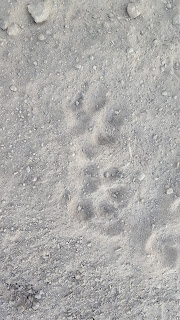I enjoy seeing it all, seeing which direction they headed and thinking about where they are going and why.
It wasn't until I decided to make one of my characters a tracker that I purchased two books on tracking by Tom Brown, Jr. Reading the books has been fun! I bought them for research and have used much of the useful information when my character Gabriel Hawke is tracking a person.
What I love the most about the books and the author is the fact he was taught to track by "Grandfather" an Apache elder. This also works well for my character who is Nez Perce and Cayuse two American Indian tribes of Oregon. In my character's background I have that he was taught by his Nez Perce grandfather to follow the animal tracks and learn the ways to be scan an area and know where to find animals and in the case of Hawke following people, where a person might try to hide or look for water.
The most fascinating thing I discovered while reading the book and practicing making marks in the sand to see how you could tell which way a person or animal looked, is while I have a knack for seeing tracks and wondering, I don't have the patience to really be a tracker. I like finding and thinking about or making a story up in my head, but I don't want to get down on my hands and knees and really look at what may or may not have happened.
 |
| See the snake trail? |
However, my character is focused and he does take the time and slowly piece together every morsel of evidence he can find.
There is so much that can be told by looking at a print. There are pressure points- seeing which way a person is looking; if they are carrying extra weight; injured; or how fast they are moving by the direction of moved dirt or debris. Then there is the telling of how old the print is. That is the hardest for me to figure out and after reading how the tracker, Tom Brown Jr. learned to tell, I know I'll never be able to learn. Other than it's fresh, it's old. That's it.
He and his friend, the grandson of the elder Apache, would watch an animal make a print and then go look at the print every hour for twenty-four hours to learn what it looked like after so many hours. That is due diligence- something I don't have!
And not only did you need to see the track each hour but you also had to learn how long depending on what the animal/person walked through. Because, grass will spring up as will some plants, while others will break. There is mud - different types which act differently; dirt - same as mud; sand again different types will act differently. dry grass, straw, bark,leaves. It all reacts differently over time.
 |
| tracks I made on the beach to see details in direction |
I love knowing all of this an having read this man's books on tracking. It helps me feel like I give my character a real basis for the things he does in the book not only while tracking in the wilderness but also when he is following leads to find the murderers.
If you like mystery novels that deal with the outdoors, horses, mules, and dogs, you might like my Gabriel Hawke series. There isn't a romance, but there is a budding male/female friendship that may end up in romance....
Paty Jager is an award-winning author of 42 novels, 8 novellas, and numerous anthologies of murder mystery and western romance. All her work has Western or Native American elements in them along with hints of humor and engaging characters. Paty and her husband raise alfalfa hay in rural eastern Oregon. Riding horses and battling rattlesnakes, she not only writes the western lifestyle, she lives it.
blog / website / Facebook / Paty's Posse / Goodreads / Twitter / Pinterest / Bookbub


Very Interesting - thanks so much!
ReplyDeleteTeresa, Thanks for stopping in and commenting!
ReplyDeleteThis is so very interesting! Tracks are very interesting to me, I know when we take our dog out for a walk , there are always different shaped tracks out there, we take him to the desert and he loves it. Your books sound like very good reads. Thank you so much for sharing this very interesting information. Have a Great week.
ReplyDeleteLicha, Thank you for stopping in and commenting. Tracking is fun and interesting. I imagine you see some diverse tracks in the desert.
ReplyDelete